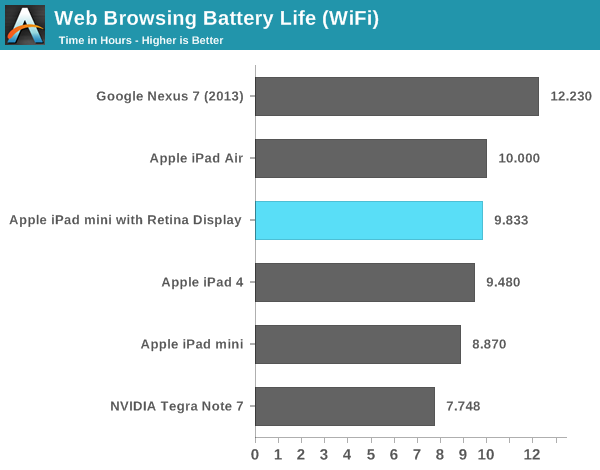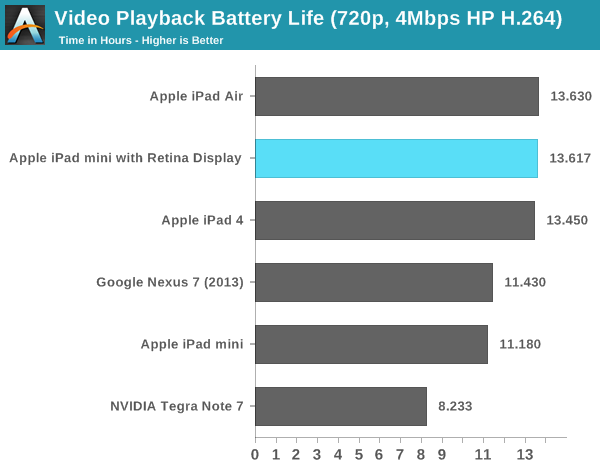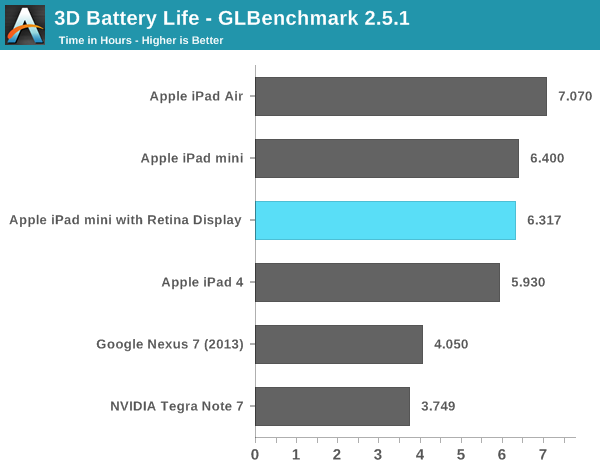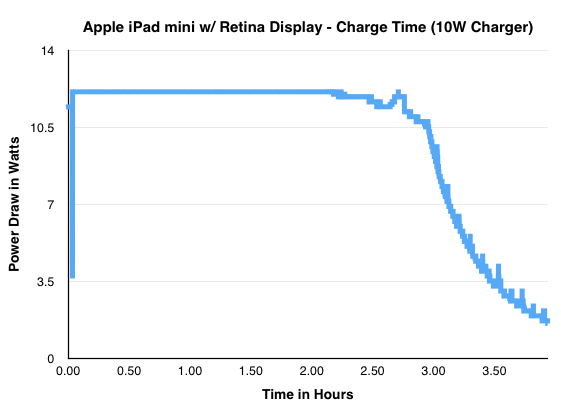Apple iPad mini with Retina Display: Reviewed
by Anand Lal Shimpi on November 16, 2013 8:00 AM ESTBattery Life
Thanks to the mini’s integrated 23.8Wh battery (and the low idle power of the 28nm A7), the Retina Display’s power consumption is more than offset. Battery life in all of our tests is at worst unchanged from the mini, but at best we’re talking about a 21% increase.
Our web browsing test shows a 10% improvement compared to the original iPad mini. The new mini with Retina Display can even last longer than a 4th generation iPad, and it’s hot on the heels of the iPad Air (I'll be updating this section with LTE and LTE hotspot results).

Video playback is where we see the biggest improvement compared to the original mini. Here the new iPad mini lasts 21% longer on a single charge, once again outlasting even the iPad 4. The iPad Air doesn’t offer any appreciable gain in battery life over the Retina mini.

Our 3D battery life test is the only one where the old mini manages to beat the new Retina model. With a 1.31% margin of victory though, it’s pretty safe to say that for current 3D gaming workloads you’ll see similar battery life out of the Retina mini as the old model. This is also the only test where the iPad Air delivers better battery life on a single charge (~11%).

Apple ships the Retina mini with a 10W USB charger and lightning cable. This appears to be the same charger as what shipped with the 3rd generation iPad (but obviously with a different cable). Using the newer 12W charger from the iPad 4/Air has no impact on charge time as the mini still only draws a maximum of 11.7W at the wall (compared to 13.8W for the iPad Air).

The iPad mini with Retina Display completes a charge from 0 to 100% in a sliver under 4 hours. That’s a little quicker than the iPad Air, and similar to the original mini with its 5W charger.











345 Comments
View All Comments
allanwood - Sunday, November 17, 2013 - link
I just checked the iPad Mini w/ Retina at the store yesterday, and it doesn't have a bonded display, just like the first mini.The easiest way to check for a space between the LCD and cover glass is to look at a reflection of a light in the screen at an angle. If you see a strong reflection and a weaker one, it has a gap. One strong reflection means it doesn't.
Spoony - Monday, November 18, 2013 - link
I am quite sure that the original Mini had optically bonded glass and panel. Multiple technical publications including this one I believe have stated that the originally Mini is that way. Additionally, my limited in-person experience with the Mini have definitely shown it to be bonded.allanwood - Monday, November 18, 2013 - link
Nope. This is from DisplayMate:"The Kindle Fire HD and and Nexus 7 both have their Cover Glass bonded directly to the LCD so there is no Air Gap like on the iPad mini, which has 3 widely separated reflections. The lack of an Air Gap helps to reduce the Reflectance for Ambient Light."
versesuvius - Saturday, November 16, 2013 - link
Apple is the company of few products and huge resources, with a brand name to boot (as in it will be bought no matter what). There are other companies with the same level or resources but they make many products. Samsung produces hundreds, perhaps thousands of individual products. Hundreds of phones. Apple produces one at a time. Nothing wrong with that, but while there is nothing that Samsung can learn from Apple, smaller companies could learn a lot from Apple. The way technology is advancing and getting cheap to the point of irrelevance, those companies could sink deadly bites into Apple, to the benefit of all around the world.KPOM - Saturday, November 16, 2013 - link
Nice review as always. Thanks for confirming our suspicions about the color gamut. I have both the Air and retina mini right now and noticed a difference. I think I'll still keep the mini and return the Air, though. The portability trounces the display difference for me.I have noticed that both the Air and the Retina Mini seem twitchy with my Sprint Aircard (Sierra Wireless 803s). It is somewhat moot for me as I bought the LTE versions, but I noticed this behavior with two different iPad Airs and the retina mini. It struggles to connect in the first place, and frequently disconnects. I did not notice this at all with the previous mini, and when I tested it with the iPhone 5s it seemed to work fine. I suspect an incompatibility somewhere as both an extended chat session and Genius Bar trip couldn't resolve the issue (we tried numerous different rested and setting changes). I haven't tried it with the wifi-only version, but I'm curious if this is a larger issue and/or something that can be resolved through firmware. I also noticed the Air had a harder time than my PC at connecting to a hotel wifi network but it eventually did (I'll experiment with the mini next week). I haven't noticed any issues connecting to Apple Airport-driven wifi networks but still need to test it with non-Apple routers.
KPOM - Saturday, November 16, 2013 - link
Are there other reasons why Apple might have chosen a lower gamut display? Does it impact battery life or is it cheaper to produce? Or is it just one more reason to try to up sell the pricier Air model?Aenean144 - Saturday, November 16, 2013 - link
Yield would be my bet.Morawka - Saturday, November 16, 2013 - link
i'm guessing nobody could make this panel but sharp, since they own IGZO tech. Then again,color could be off because the glue is still wet lol......nunomoreira10 - Saturday, November 16, 2013 - link
The gamut is generally depended on the leds used in the baclight.higher gamut leds are less eficient and more expensive then lower gamut leds, so its a trade-off between battery life and quality.
Morawka - Saturday, November 16, 2013 - link
What do you know? anand doing another apple review.